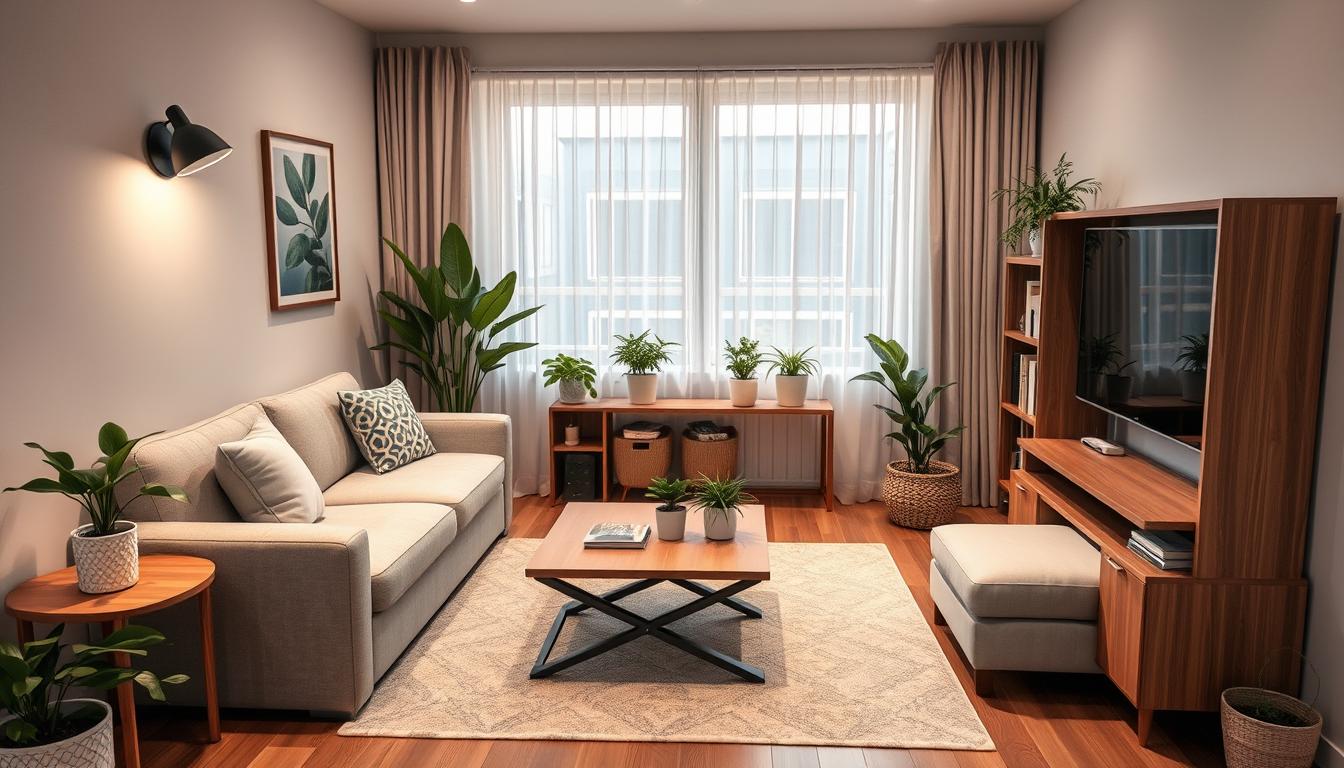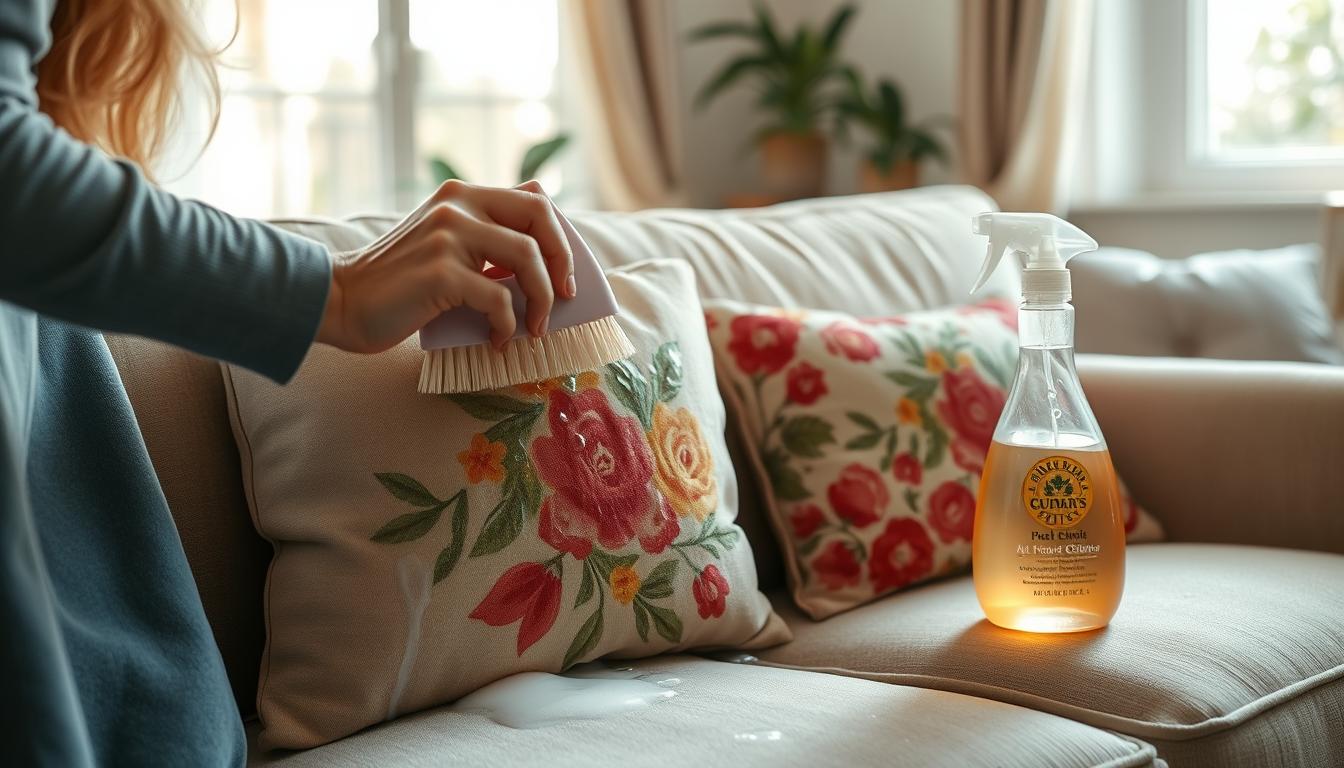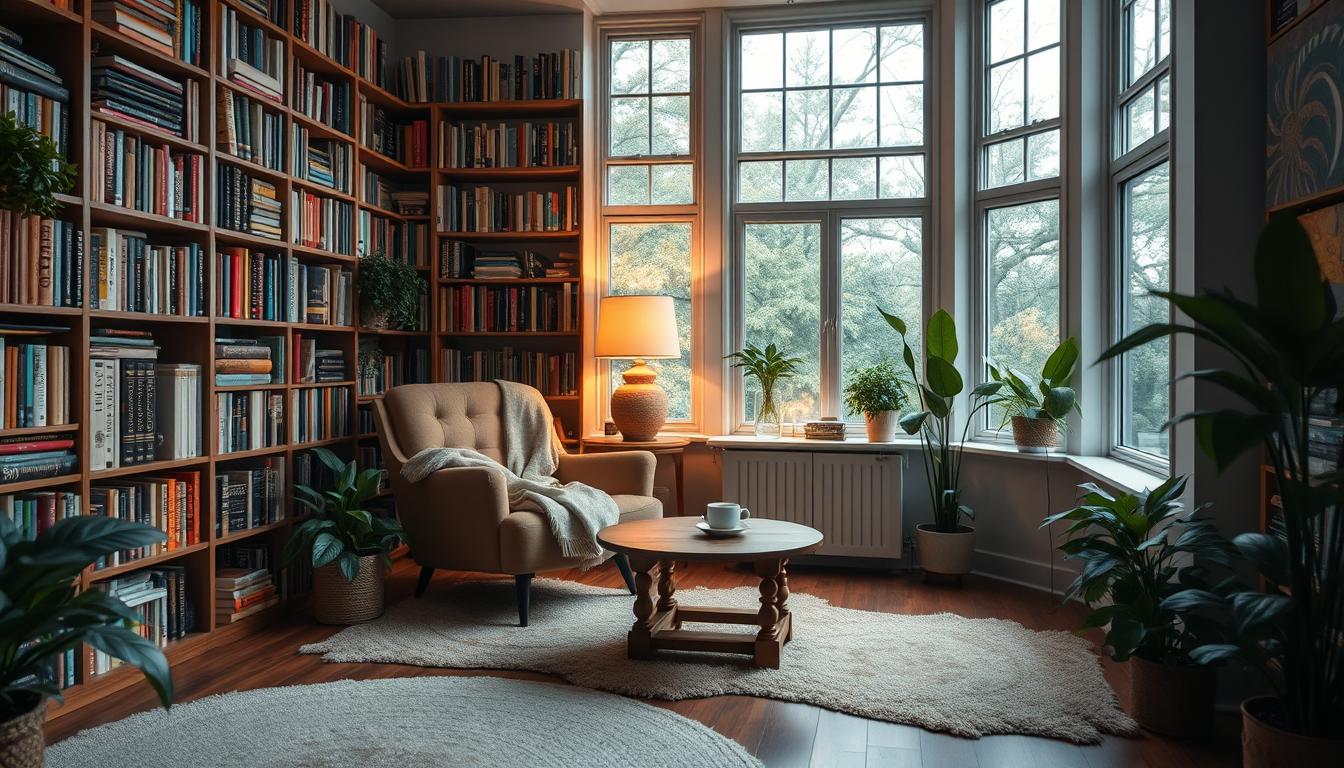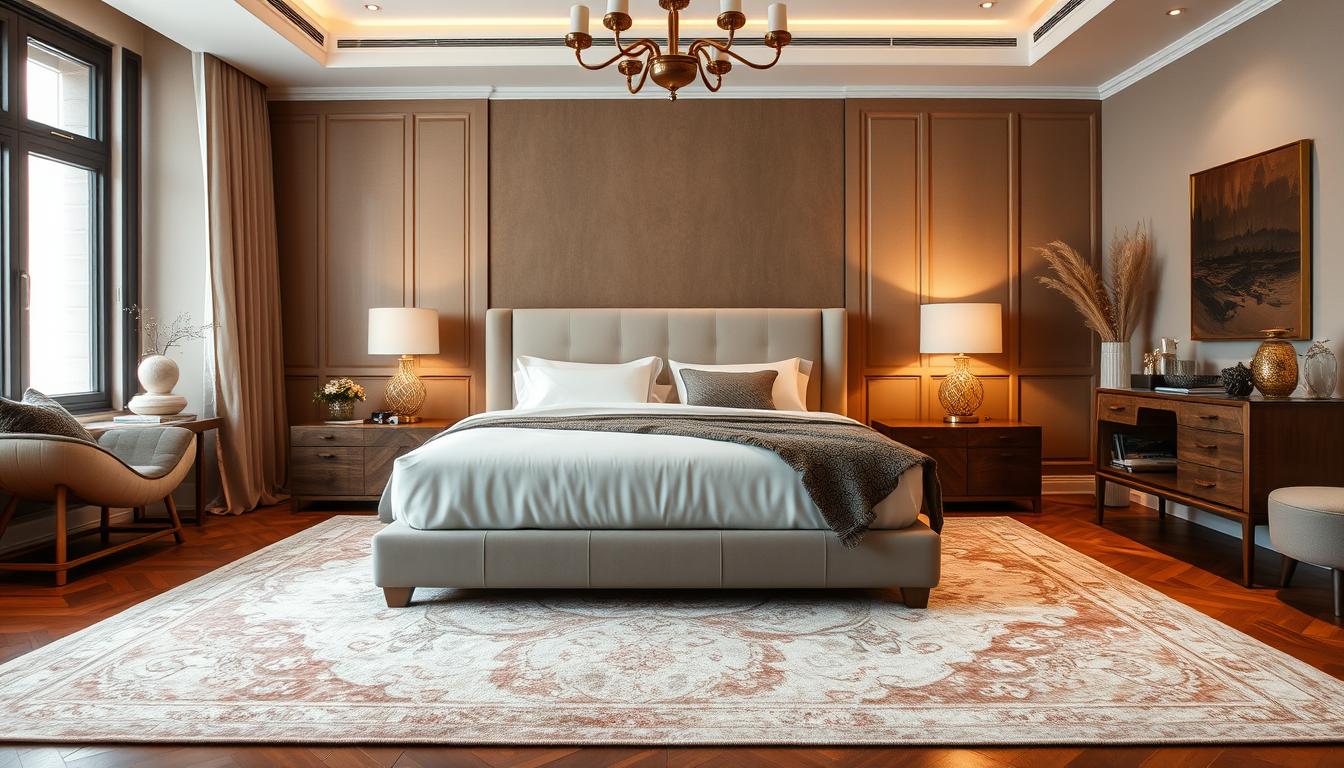As an interior design enthusiast, you may have encountered the challenge of decorating a blank wall in your home without making the space feel cluttered or overwhelming. Blank walls can sometimes seem like a daunting task, but with the right approach, you can transform them into stunning focal points that enhance the overall aesthetic of your living space.
In this article, we’ll explore a variety of creative and practical solutions to help you fill a blank wall in a visually appealing way, without compromising the open and minimalist feel of your home. Whether you’re looking to add a touch of personality, create a cozy ambiance, or showcase your personal style, we’ve got you covered.
Key Takeaways
- Discover creative ways to fill a blank wall without overcrowding your space
- Learn how to enhance minimalist and modern aesthetics through strategic wall decor
- Explore techniques for achieving balance and visual harmony in your interior design
- Understand the importance of negative space and how to utilize it effectively
- Gain practical tips for personalizing your walls and showcasing your style
Understanding the Purpose of Blank Walls
Blank walls can serve an important purpose in your home’s interior design. By strategically leaving some walls unadorned, you can create visual breathing space and enhance the overall minimalist or modern aesthetics of a room. This allows your eyes to rest, making the space feel more serene and balanced.
Creating Visual Breathing Space
In a world filled with constant stimulation, blank walls offer a refreshing respite. They provide a sense of visual rest, preventing a room from feeling overwhelmed or cluttered. This open, uncluttered look aligns with the current design trends favoring clean lines, simplicity, and an unencumbered aesthetic.
Enhancing Minimalist and Modern Aesthetics
Blank walls seamlessly integrate with minimalist and modern interior design styles. By leaving select walls free of décor, you can create a sleek, sophisticated ambiance that exudes a sense of calm and tranquility. This strategic use of negative space allows the architecture and furnishings to take center stage, resulting in a visually striking and harmonious space.
https://www.youtube.com/watch?v=fJBYMSrzYTc
Whether you’re aiming for a serene, minimalist vibe or a modern, open-concept layout, embracing blank walls can be a powerful tool in your interior design arsenal. By thoughtfully balancing visual elements, you can craft a space that feels uncluttered, rejuvenating, and aesthetically pleasing.
Achieving Balance: Decorating without Overcrowding
Decorating a blank wall can be a delicate balancing act. You want to add visual interest and personality to the space, but too much clutter can quickly make the area feel overwhelming. The key is to find the right balance between balanced decor, avoiding clutter, and visual harmony. By following a few simple principles, you can create a cohesive design that is both visually appealing and functional.
Start by decluttering and carefully editing your wall decor. It’s tempting to fill every inch of a blank wall, but resist the urge. Instead, focus on a few intentional styling pieces that truly speak to you. This minimalist approach will help maintain a sense of visual breathing space and prevent your space from feeling overwhelmed.
When selecting wall decor, aim for a mix of sizes, shapes, and textures to add visual interest without overcrowding. The Three-Element Design Principle is a great guideline – try grouping three items of varying sizes and heights to create a balanced, asymmetrical display. Remember to leave about 5 inches between each element to avoid a cramped, cluttered appearance.
| Balanced Decor Tips | Avoiding Clutter | Achieving Visual Harmony |
|---|---|---|
|
|
|
By following these tips, you can create a functional decor that is both visually appealing and harmonious. The key is to approach wall decor with intention, carefully curating each element to achieve the perfect balance of visual harmony and minimalist style.
How to Fill a Blank Wall
Faced with a blank wall, the temptation to overcrowd the space can be strong. However, by strategically selecting the right wall decor ideas, you can transform an empty expanse into a visually captivating focal point without sacrificing the room’s balance and breathing room. From gallery wall design to shelving solutions, there are numerous ways to fill a blank wall while maintaining a cohesive and intentional aesthetic.
One popular approach is to create a gallery wall, where you can artfully arrange a mix of artwork, photographs, and personal mementos. The key to a successful gallery wall is to ensure there is enough hierarchy in color, size, or framing to guide the viewer’s eye. By strategically layering different-sized pieces, you can achieve a sense of depth and visual interest without overwhelming the space.
Another option is to incorporate shelving solutions. Built-in bookshelves or floating wall-mounted units can provide both storage and a canvas for displaying decorative accents, from plants and vases to candlesticks and small sculptures. The versatility of shelving allows you to curate a personalized display that reflects your style and interests.
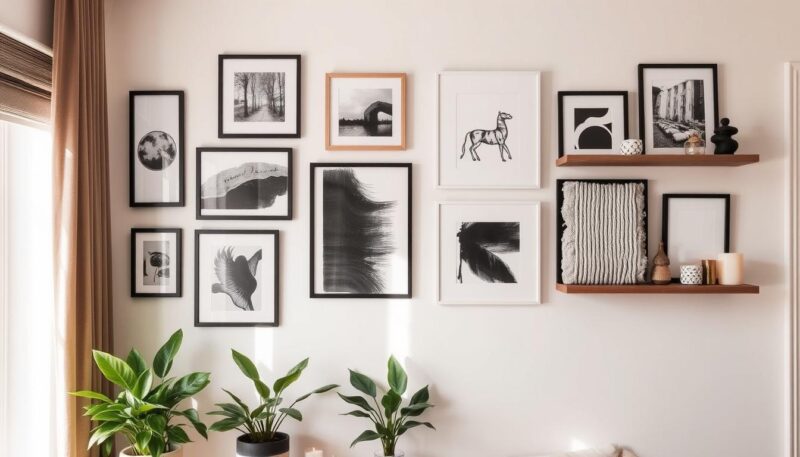
Beyond gallery walls and shelving, the strategic placement of mirrors can work wonders in filling a blank wall. Oversized floor-to-ceiling mirrors, such as the stunning 7′ Anthropologie Gleaming Primrose mirror, can create the illusion of depth and make a bold statement. Arched floor mirrors are another eye-catching option that can add drama and elegance to a space.
When selecting artwork and wall decor, be mindful of how they complement the existing design elements in the room. In spaces with bold colors and patterns, opt for larger, more minimalist pieces that won’t compete for attention. Conversely, in neutral-toned rooms, consider incorporating pops of color or textural elements like woven art or tapestries to create visual interest.
Remember, the key to filling a blank wall successfully is to strike a balance between visual appeal and functional purpose. By thoughtfully layering textures, colors, and design pieces, you can transform an empty space into a personalized and inviting display that enhances the overall aesthetic of your home.
Embracing Negative Space and Visual Rest
In the pursuit of creating visually stunning and harmonious interiors, the importance of negative space often goes overlooked. Contrary to the common belief that every wall must be filled, embracing negative space can be a game-changer in your design approach. By intentionally leaving some walls blank or minimally decorated, you can cultivate a sense of openness and tranquility that is both captivating and soothing.
Appreciating the Beauty of Simplicity
The beauty of simplicity lies in its ability to create a calming and serene atmosphere. By embracing negative space, you can allow your eyes to rest and your mind to find respite from the constant visual stimuli that often overwhelm our daily lives. This intentional design strategy can contribute to a harmonious, balanced environment that promotes well-being and mindfulness.
Studies have shown that the effective use of negative space in interior design can have a profound impact on our emotional and psychological well-being. Negative space can invoke a sense of relaxation, reduce stress, and even improve focus and productivity, particularly in workspaces and home offices. By minimizing distractions and allowing for visual rest, you can create a space that is truly conducive to a serene and calming environment.
Furthermore, the incorporation of negative space can create the illusion of a larger, more spacious environment, which is particularly beneficial in small apartments and homes. By striking a harmonious balance between positive space (occupied by furniture and decor) and negative space (empty walls and floors), you can achieve a visually appealing and intentionally styled interior that resonates with your personal aesthetic.
“Negative space is just as important as positive space in interior design, playing a crucial role in creating a well-balanced, visually appealing environment.”
As you embark on your interior design journey, embrace the power of negative space and the beauty of simplicity. Allow your walls and floors to breathe, and let the intentional use of space guide you towards a serene and harmonious atmosphere that nourishes both your senses and your soul.

Conclusion
In conclusion, this article has provided a comprehensive guide on how to fill a blank wall without overcrowding your space. By understanding the purpose of blank walls, achieving a balanced approach to decor, and embracing the power of negative space, you can create stylish, minimalist, and functional interior designs that enhance the overall aesthetic of your home. The key is to approach wall decor with intentionality, focusing on solutions that are both visually appealing and enhance the sense of openness and tranquility in the space.
Whether you choose to incorporate furniture, framed art, wood focal walls, sculptural objects, greenery, or large wall art, the strategies outlined in this article will help you transform your blank walls into captivating focal points that complement the minimalist design and visual harmony of your living spaces. By prioritizing functionality, decluttered spaces, and a balanced integration of design elements, you can create a harmonious and inviting atmosphere that promotes a sense of rest and relaxation.
Remember, wall decor is not just about filling empty spaces; it’s about curating a space that reflects your personal style and values. By embracing the power of wall decor strategies, you can elevate the overall functionality and aesthetic appeal of your home, creating a haven of visual harmony and tranquility. Keep exploring the versatile options available, and don’t hesitate to tag @nestorations on social media to share your wall decor transformations and connect with a community of design enthusiasts.
Source Links
- https://carlaaston.com/designed/wall-decor-solutions-for-tall-blank-walls
- https://www.elledecor.com/design-decorate/how-to/g451/blank-wall-solution/
- https://foyr.com/learn/best-wall-decor-ideas
- https://stylebyemilyhenderson.com/blog/struggling-with-a-big-empty-wall-we-help-4-readers-you-figure-out-the-best-ways-to-fill-it
- https://nestorations.com/what-to-do-with-a-blank-wall-2/
- https://studio-mcgee.com/4-ways-to-fill-a-big-blank-wall/
- https://simplykalaa.com/how-to-decorate-a-blank-wall/
- https://www.rustyroostermetal.com/blogs/news/how-to-arrange-wall-art?srsltid=AfmBOoq3ef4TCKLoqvFGMRUzGmoCr2lN2VNdLFygbOY_RVoP-HP1mSTj
- https://www.meredithlynndesigns.com/blog/2019/2/13/how-to-fill-that-big-empty-wall
- https://stefanasilber.com/style-a-big-blank-wall/
- https://www.architecturaldigest.com/story/wall-decor-ideas
- https://www.whisperingbold.com/post/mastering-the-art-of-negative-space-embrace-the-void-in-interior-design
- https://www.livingetc.com/advice/negative-space-in-interior-design
- https://www.decoist.com/negative-space-interior-design/
- https://nestorations.com/what-to-do-with-a-blank-wall/
- https://medium.com/@282496078/how-to-decorate-a-large-blank-wall-391872f600cf

